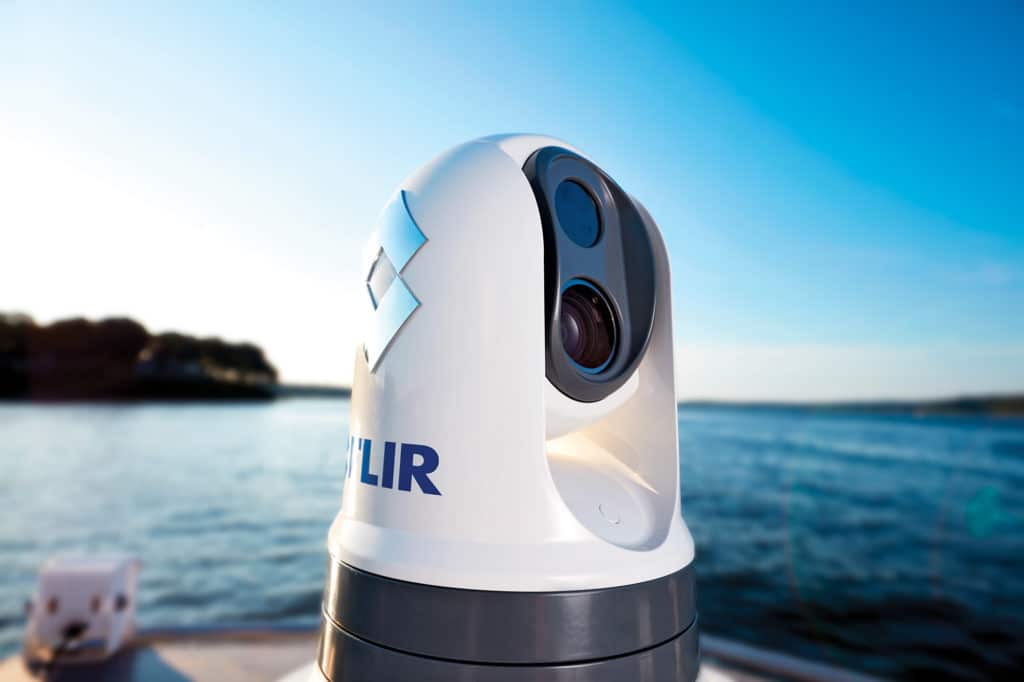
“Man overboard!”
The words still ring in my ears, irrespective of the fact that the MOB wasn’t among our crew that day on Washington state’s Puget Sound. Unfortunately, we were too far away to decipher the situation with our eyes, and by the time we had a pair of binoculars on deck, another crew had rescued the MOB.
While the situation ended happily, it’s easy to wonder what could have happened if this incident hadn’t unfurled near a crowded mark rounding or, worse, if no one had spotted the MOB at all.
Fortunately, today’s technology can help. FLIR Systems’ latest-generation M300 Series fixed-mount cameras employ better optics, advanced image processing, improved target tracking and more-sensitive thermal cores than previous models, giving users better situational awareness, increased confidence and a menu of video-output options.
Sharp-eyed readers will notice that the M300 Series cameras use similar-looking but larger gimbals than FLIR’s previous-generation cameras. The extra space affords bigger optical zooms. Jim McGowan, Raymarine’s Americas marketing manager, notes that M300 cameras represent a ground-up effort between FLIR and Raymarine (FLIR acquired Raymarine in 2010). M300 cameras use FLIR’s Boson thermal-imaging cores, which are a significant improvement from FLIR’s previous-generation Tau 2 cores.
M300 Series cameras are available in five configurations, all of which sport two-axis gyrostabilization, IPX6 protection ratings, and the ability to withstand 100-knot winds. The product lineup starts with the M300C ($6,500): a high-definition, long-range, daylight-only camera with 360-degree continuous pan and plus or minus 90-degree tilt movements. The M300C has a 30x optical zoom backed up by a 12x digital zoom (for a maximum combined optical/electronic zoom of 360x), variable fields of view, and a Sony-built visible-light camera core that delivers high-end resolution and low-light capabilities.
FLIR’s M332 ($8,500) swaps out the daylight-only camera for a Boson 320 core with 320-by-256 thermal-image resolution and a 24-by-18-degree FOV. The M332 has a fixed optical focus of 12 feet to infinity, a 4x digital zoom, and the ability to pan through 360 degrees and tilt through plus or minus 90 degrees.
The M364 ($14,200) has the same technical specifications as the M332, but its upgraded Boson 640 thermal-imaging core delivers 640-by-512 image resolution and an 8x digital zoom.
Yachtsmen seeking dual daylight- and thermal-imaging payloads should consider the M364C ($20,500), which pairs the M300C’s high-definition, visible-light camera with the M364’s Boson 640 thermal-imaging core. Additionally, the M364C has FLIR’s Color Thermal Vision and Multispectral Dynamic Imaging technologies. CTV blends imagery from the daylight camera with imagery from the thermal-imaging camera and overlays the hybrid imagery with colors for better identification.
“The M364C pulls imagery off of its visible-light camera, reduces this down to hues and applies it on top of thermal imagery in real time,” McGowan says. “You can see the color return of the [buoy] flash.”
Additionally, FLIR’s MSX technology embeds image details such as edges and outlines from the camera’s visible-light sensor onto its thermal imagery.
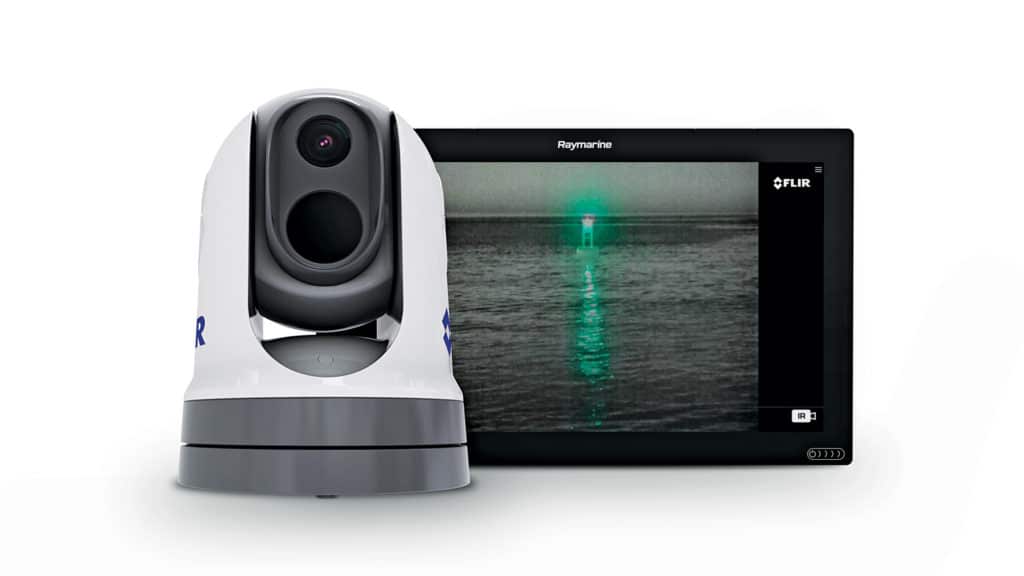
“It fools the eyes and brain and helps solidify the image,” McGowan says, adding that the MSX layer makes faint edges become crisp. “If you see a sailboat through a thermal camera, it will be a triangle, but if you see it with MSX, you’ll see the edges of sails, the mast and rigging—details that otherwise would have been lost.”
The M364C LR ($29,500) is the final camera in the M300 lineup and is identical to the M364C, except that it features an 18-by-13.5-degree FOV (hence it’s “long-range” moniker).
“That’s the only difference,” McGowan says, explaining that the M364C LR is better suited for ships, as its narrower FOV exaggerates vessel motion.
All M300 Series cameras are fitted with an attitude and heading reference system sensor, which works with the camera’s horizontal and vertical stabilizer motors to remove vessel motion from the camera’s displayed video feed.
“For situational awareness, wider FOVs are better,” he says, adding that the M364C is typically the better choice for vessels shy of superyacht status.
In addition to AHRS sensors, all M300 Series cameras allow users to track AIS or radar targets using FLIR’s slew-to-cue tracking. Users select any AIS or radar target, and the camera automatically aims its unblinking eye on the scene.
“In a MOB emergency, the camera can automatically track the situation if someone pushes the MFD’s MOB button,” McGowan says, adding that the camera pulls the vessel’s position information at the time of the MOB incident from the multifunction display. “The camera remains [fixed on the target] while the boat moves under it.”
Thermal-image-enabled M300 cameras also have infrared-image-detection capabilities in their Boson cores, allowing the cameras to differentiate between water and nonwater objects in daylight or thermal scenes. And for anyone who cruises with Raymarine Axiom MFDs, the functionality also lets the cameras work with Raymarine’s ClearCruise augmented reality system.
M300 cameras also play nicely with Furuno, Garmin and Simrad displays. “Each manufacturer has access to [FLIR’s] software-developer kits and can build their own interfaces,” McGowan says, adding that users can control their cameras via their display’s touchscreen interface or add an optional FLIR-built joystick to their helm.
M300 cameras also provide user-friendly video-output options. “Our older cameras only had an analog-out signal, so they were restricted to standard-definition , and it was hard to see the camera’s feed in multiple places,” McGowan says. “In the new cameras, the analog-out signal is still there, but we’ve added a video-over-IP—or Ethernet streaming and high-definition .”
Users can simultaneously share the camera’s output with multiple screens by plugging it into the yacht’s Ethernet network or connecting directly to the camera’s server. Cooler still, if the boat has connectivity, users can stream M300 imagery ashore via browser-enabled devices.
M300 Series cameras deliver a menu’s worth of features, capabilities and signal-output options, while offering the kind of MOB-detection capabilities that can mean the difference between an unexpected swim and a tragedy.
New Electronics
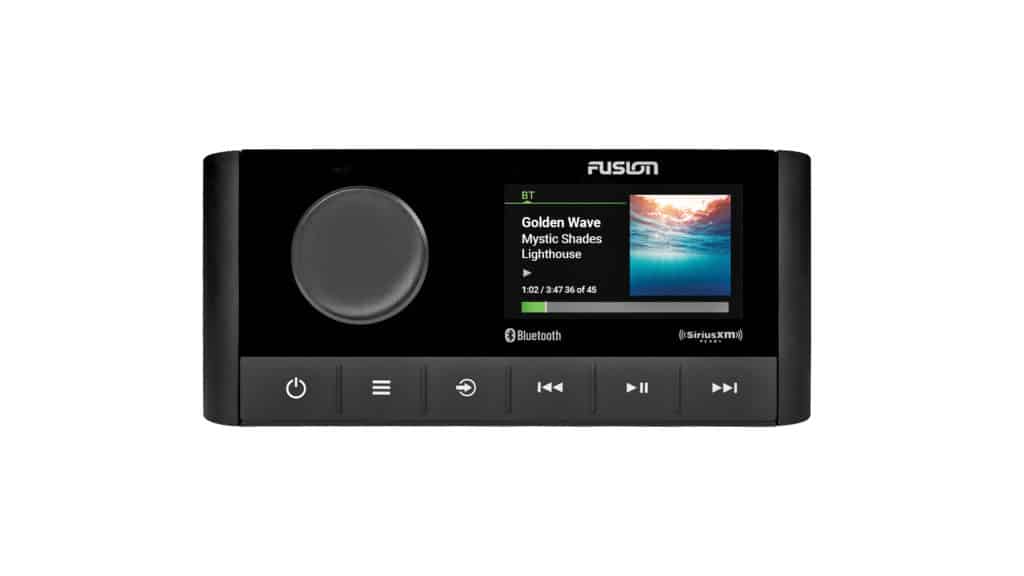
Fusion Entertainment’s MS-RS210 receiver ($350) is intended for use on flybridges, tenders or smaller boats, and comes with the company’s Digital Signal Processing technology. The MS-RS210 has an optically bonded 2.7-inch full-color LCD that shows album artwork and other metadata, and boaters can set up their DSP profiles to best match their yacht’s spaces and acoustic preferences. Check it out, at fusionentertainment.com.
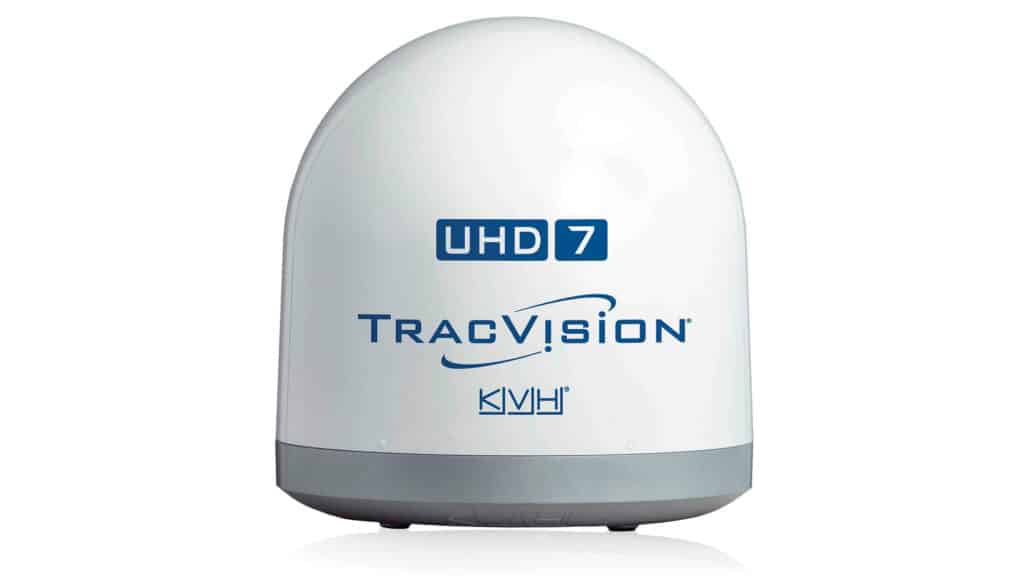
KVH’s TracVision UHD7 receive-only antennas deliver ultra-high-definition 4K programming from DirecTV and high definition from other satellite-TV providers, including Dish Network and Bell. The antennas ($13,995) use KVH’s TriAD technology, which lets them receive DirecTV programming, local channels and DVR support by simultaneously tracking three satellites. Check it out, at kvh.com.
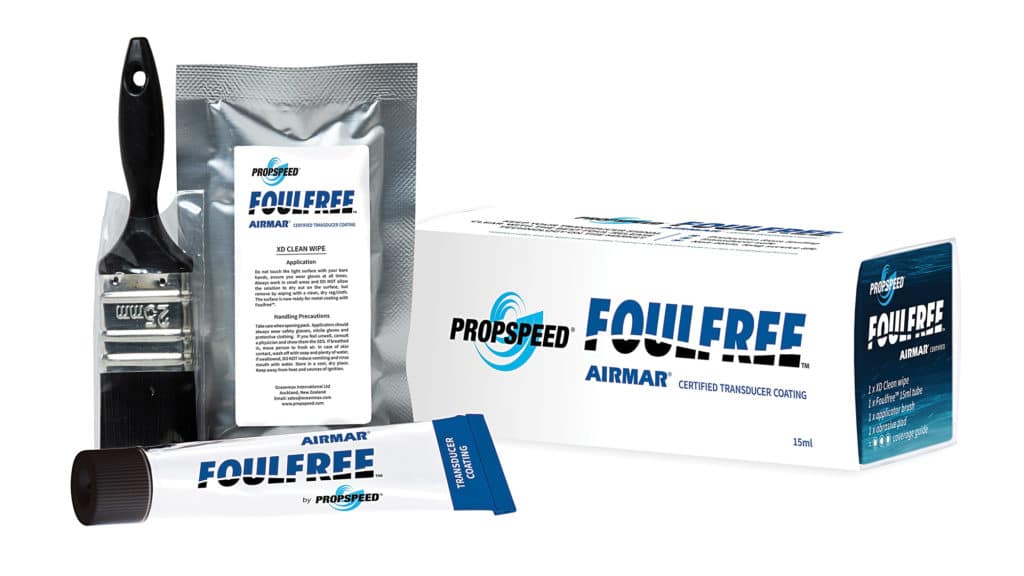
Transducers provide an onscreen visual of everything below the keel, provided that the tech isn’t covered with growth. Propspeed’s Foulfree Transducer Coating ($40) is made to reduce growth on transducer surfaces without harming the marine environment. Rather than using biocides, Foulfree becomes slippery in water, so any marine growth washes away with just a few knots of boat speed. Check it out, at oceanmax.com.









